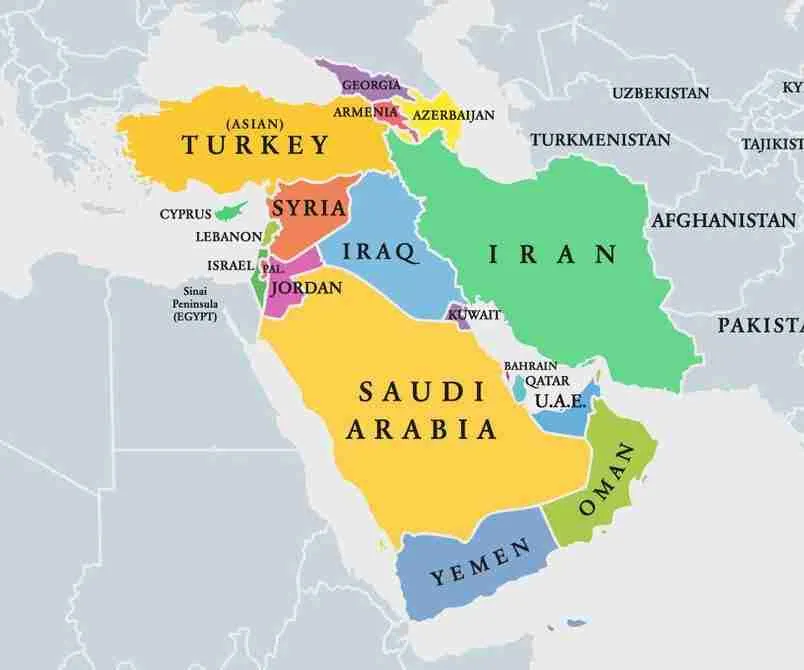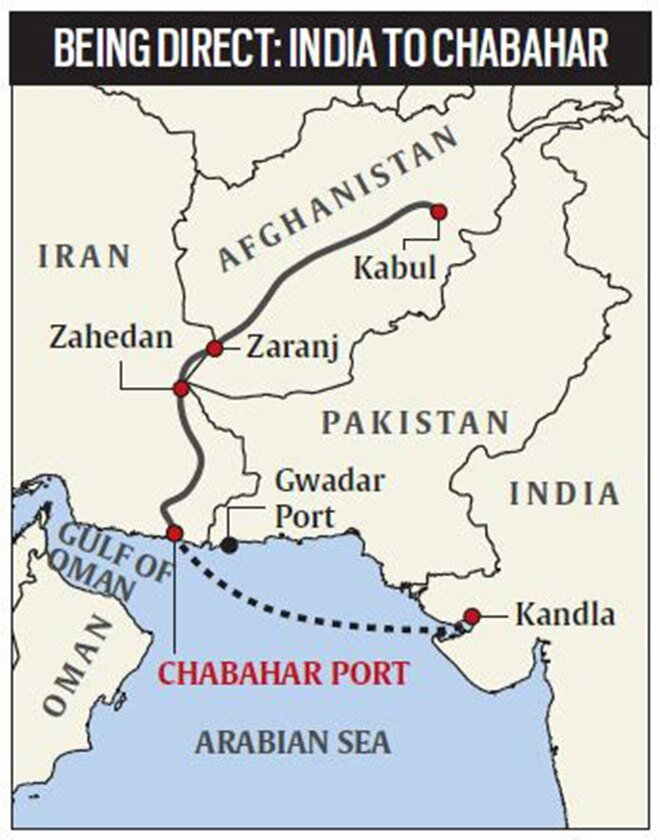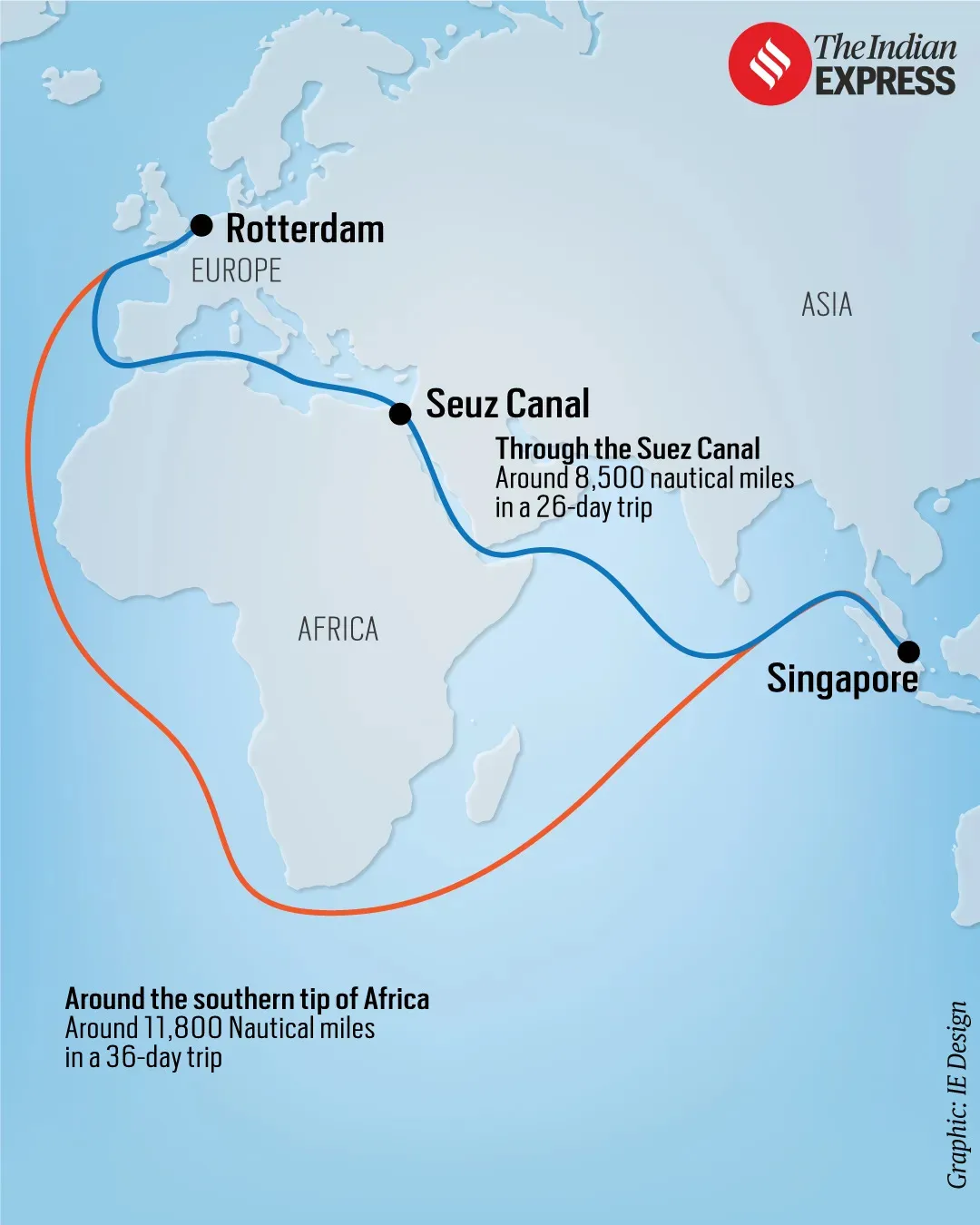International Relations
West Asia Conflict & India's Interests
This editorial is based on “Fallouts of Iran-Israel conflict: Disruptions in oil supplies, raised prices” which was published in The Indian Express on 17/06/2025. The article brings into picture the impact of Israeli strikes on Iran, triggering a 7% oil price surge and highlighting risks to the Strait of Hormuz. It underscores challenges for India in energy security, inflation control, and diplomatic ties with Israel and Iran, including the Chabahar port project.
For Prelims: West Asian region, Chabahar Port, Belt and Road Initiative,Organization of Islamic Cooperation, Non-Aligned Movement , Red Sea, Strait of Hormuz,Cape of Good Hope, International North-South Transport Corridor.
For Mains: Key Drivers of Conflict in West Asia, Implications of West Asian Conflict on India.
Recent Israeli strikes on Iran have triggered an escalation spiral, causing significant shocks to global energy markets, with oil prices jumping 7%. While Iran's oil production capacity stands at 3.3 million barrels per day, existing sanctions have already reduced its exports to just 1.6 million barrels daily. However, the critical concern lies in the potential closure of the Strait of Hormuz, through which a fifth of global oil supply transits. The escalating West Asian conflict poses multifaceted challenges for India, from energy security and inflation management to the delicate diplomatic balancing act between Israel and Iran while protecting strategic interests like the Chabahar port project.
What are the Key Drivers of Conflict in West Asia?
- Israeli-Palestinian Conflict: The ongoing Israeli-Palestinian conflict remains the central driver of instability in the region, with profound political, religious, and territorial disputes.
- Despite international calls for a ceasefire (including recent United Nations General Assembly’s permanent ceasefire call), Israeli military actions, especially in Gaza, have exacerbated tensions.
- This has led to broader regional involvement, with Hezbollah and Hamas escalating their attacks on Israel, deepening the crisis.
- Despite international calls for a ceasefire (including recent United Nations General Assembly’s permanent ceasefire call), Israeli military actions, especially in Gaza, have exacerbated tensions.
- Iran-Israel Rivalry and Proxy Warfare: The deepening rivalry between Israel and Iran, fueled by ideological differences, has exacerbated regional instability. Iran's support for Hezbollah, Hamas, and other militia groups challenges Israel's regional dominance.
- For instance, Iran's missile strike on Israel’s military base in September 2024 (in retaliation for the assassination of Hezbollah leader) demonstrated its growing warfare intent.
- Iran's regional influence is evident as its proxies continue targeting U.S. and Israeli interests, escalating tensions across Lebanon, Syria, and Yemen.
- Sectarian Divides and Proxy Conflicts: The divide on the basis of religious line has become a significant source of instability, with countries like Saudi Arabia and Iran backing opposing factions across the region.
- The Houthi rebels in Yemen, supported by Iran, continue to target Saudi and UAE interests, while Saudi Arabia supports another faction backed forces in Syria and Iraq.
- The war in Yemen has claimed over 250,000 lives and continues to fuel instability, impacting the entire Gulf region’s security.
- U.S. and Western Influence vs. Growing Chinese Role: The strategic rivalry between the U.S. and China in West Asia has created competing spheres of influence.
- U.S. support for Israel, coupled with its military presence in the Gulf against Iran (due to historical conflict and most recently Iran downed a U.S. Global Hawk drone in the Strait of Hormuz in 2019), has led to heightened tensions with Iran.
- On the other hand, China’s successful mediation of the Saudi-Iran peace deal in 2023 signals a shift in power dynamics.
- China's diplomatic success contrasts with U.S. policies, which have often been seen as unilateral, further complicating the region’s geopolitics.
- Resource Competition and Energy Security: The region's vast energy reserves remain a primary driver of conflict, with global powers vying for influence over oil-rich territories.
- Iran’s crude oil production, standing at 3.4 million barrels per day in 2024, represents 3% of global production, while any disruption could send oil prices soaring, impacting global economic stability.
- Economic Instability and Rising Unemployment: Economic hardship, exacerbated by sanctions and war, has fueled unrest in several West Asian countries.
- For instance, Lebanon's economic collapse, with inflation reaching 200%, has made it a hotbed for protests.
- Similarly, youth unemployment in countries like Saudi Arabia and Iraq, which stands at 30-35%, has led to increased militancy and radicalization.
- Economic instability makes populations more vulnerable to extremist ideologies, heightening the overall conflict risk.
- Nuclear Proliferation and Arms Race: Iran's nuclear ambitions continue to be a flashpoint in the region.
- Despite international efforts, including the 2015 nuclear deal, Iran has significantly expanded its nuclear capabilities, enriching uranium to 60% purity by early 2024.
- The possibility of Iran acquiring nuclear weapons has prompted regional powers like Saudi Arabia to reconsider their own nuclear programs, triggering a potential arms race that could destabilize the region further.
What are the Implications of West Asian Conflict on India?
- Diplomatic and Strategic Dilemmas: India faces a complex diplomatic challenge due to its ties with both Israel and Iran.
- India’s position as a non-aligned power or multi-aligned power is tested by the Israel-Palestine issue and the growing rivalry between Israel and Iran.
- The 2024 escalation, with Israel targeting Iranian assets, has forced India to walk a tightrope, calling for restraint from both sides while maintaining strong ties with each.
- India's strategic interests, particularly in the Chabahar port project, demand careful navigation of this volatile situation.
- Energy Security Issue and Rising Oil Prices: West Asian conflicts, particularly the tensions between Israel and Iran, have direct consequences on India's energy security.
- As India imports over 80% of its oil, any disruption in oil supply from the region has a significant economic impact.
- The escalating conflict, especially the potential closure of the Strait of Hormuz, threatens global oil supply lines.
- Brent crude oil prices surged by 9% following Israeli airstrikes on Iranian targets, signaling increased volatility.
- Economic Strain Due to Higher Freight and Shipping Costs: The conflict has disrupted critical trade routes, leading to a rise in shipping costs and delays in global supply chains.
- The Red Sea, a vital route for Indian exports, is now facing security threats, which could increase the cost of shipping goods.
- A detour around the Cape of Good Hope, an alternative route to the Red Sea, could add 10-14 days to shipping times, further raising freight costs by 20%.
- This will likely inflate prices for Indian exports, impacting sectors like textiles and electronics.
- Impact on Trade with Israel and Iran: India’s trade with both Israel and Iran has been adversely affected by the conflict.
- The economic turmoil has led to a drop in Indian exports to both nations, with exports to Israel declining by 63.5% in the first half of 2024.
- Similarly, trade with Iran also fell sharply. As India maintains crucial trade relations with both, especially in defense and oil, this downturn represents a serious setback for its strategic economic ties.
- Threats to Indian Expatriates and Remittances: With millions of Indians working across the Gulf and West Asia, the region’s instability poses a direct risk to the expatriate workforce.
- India’s overseas workers in countries like Lebanon and Saudi Arabia are vulnerable to escalating violence, which could lead to mass evacuations.
- Any intensification of conflict here could disrupt their safety and income, which is critical for India's remittances that account for around 3% of GDP.
- Inflationary Pressures and Economic Slowdown: With oil prices on the rise, India faces inflationary pressures that could slow economic growth.
- A $10 per barrel increase in global oil prices raises India's current account deficit by nearly $10 billion.
- India's inflation rate could spike further, affecting food and fuel prices, which are critical to its large population.
- As the global growth outlook weakens amid these tensions, India's growth prospects may be hindered, as reflected in the World Bank’s revised forecast of 2.3% for 2025(Global GDP growth).
- Geopolitical Shifts and China’s Influence: The growing Chinese influence in West Asia, including the Saudi-Iran peace deal brokered by Beijing, impacts India’s strategic calculus.
- As China increases its presence through economic and diplomatic channels, India is pressured to reassess its regional engagements.
- China’s Belt and Road Initiative (BRI) and its growing ties with Iran, including energy deals, create new geopolitical dynamics, which India must address to protect its interests in the region, particularly in areas like the International North-South Transport Corridor (INSTC)
What Measures can India Adopt to Secure its Interest in West Asia Amid Conflicts?
- Strengthening Diplomatic Engagement with Regional Powers: India must adopt a proactive diplomatic strategy, enhancing dialogue with both Israel and Iran to safeguard its strategic and economic interests.
- India should engage in direct dialogue with both Israel and Iran to safeguard its strategic and economic interests.
- The Indian Foreign Minister has recently discussed the ongoing regional situation with both nations, emphasizing the need to avoid escalation, exercise restraint, and return to diplomacy.
- Increased diplomatic outreach to key Gulf Cooperation Council (GCC) states, like Saudi Arabia and the UAE, will help India preserve its economic interests while also playing a constructive role in reducing regional tensions.
- India should engage in direct dialogue with both Israel and Iran to safeguard its strategic and economic interests.
- Expanding Regional Security Cooperation and Counterterrorism Initiatives: India should strengthen its counterterrorism partnerships in West Asia, particularly with countries like Israel, Jordan, and Egypt.
- By enhancing intelligence-sharing frameworks and establishing joint security initiatives, India can mitigate the risks posed by extremist groups operating in the region.
- Diversifying Energy Imports and Building Strategic Reserves: To reduce dependency on any single source of oil and gas from West Asia, India must diversify its energy imports by exploring new suppliers from Africa, Central Asia, and even Latin America.
- Establishing long-term energy agreements with non-Gulf nations will provide a buffer against supply disruptions.
- Simultaneously, India should accelerate the development of strategic petroleum reserves to provide insulation against sudden price shocks or supply chain interruptions stemming from regional conflicts.
- Enhancing Maritime Security and Protecting Trade Routes: Given the growing instability in the Persian Gulf and the Strait of Hormuz, India should bolster its naval presence and maritime security operations in these critical waters.
- Strengthening cooperation with global powers such as the U.S., Russia, and Japan, as well as key regional partners, will help secure critical shipping lanes vital for India’s energy imports and international trade.
- By expanding its maritime strategy, India can ensure the free flow of commerce and energy, while also asserting its presence in regional security matters.
- Leveraging Economic Diplomacy to Maintain Regional Stability: India must actively use economic diplomacy as a tool to safeguard its interests in West Asia.
- Strengthening bilateral trade agreements, expanding investment partnerships, and advancing infrastructure projects (such as Chabahar port) will solidify India’s economic footprint in the region.
- By focusing on mutually beneficial economic cooperation, India can cultivate deeper ties with both regional powers and smaller states, ensuring that its presence in the region is seen as a stabilizing force amid the ongoing conflicts.
- Promoting People-to-People Ties and Soft Power Diplomacy: India should leverage its strong diaspora and people-to-people connections in West Asia to build cultural and educational bridges with regional states.
- By increasing academic exchanges, cultural diplomacy, and promoting Indian expertise in technology, healthcare, and education, India can strengthen its soft power.
- This approach will not only enhance India’s influence but also provide an avenue for resolving conflicts through non-military means, positioning India as a global advocate for peace and cooperation.
- Fostering Regional Economic Integration Through Connectivity Projects: India should accelerate regional integration initiatives by pushing for expanded connectivity projects, such as the International North-South Transport Corridor (INSTC), to enhance trade and transport links between West Asia, Central Asia, and India.
- These projects will not only facilitate smoother and more secure trade routes but also promote regional stability by fostering economic interdependence.
- By facilitating infrastructure development, India can play a pivotal role in shaping the region’s economic future amidst the ongoing conflicts.
- Strengthening Humanitarian Engagement and Crisis Response Mechanisms: India should establish a comprehensive humanitarian response framework in cooperation with UN agencies to assist populations affected by conflict in West Asia.
- By providing medical aid, relief supplies, and reconstruction assistance, India can enhance its image as a peacebuilder and contribute to regional stability.
- Engaging in proactive peacebuilding efforts will allow India to be seen as a neutral actor committed to alleviating human suffering, thereby solidifying its diplomatic standing across the region.
Conclusion:
West Asia's complex conflicts present significant challenges for India, from energy security to diplomatic balancing. By adopting a proactive approach through diplomatic engagement, security cooperation, and economic diplomacy, India can safeguard its interests while promoting regional stability. Strengthening ties with regional powers and diversifying energy sources will further enhance India's strategic position. Ultimately, India's role as a stabilizing force in the region will be crucial for its long-term security and economic prosperity.
|
Drishti Mains Question: "Discuss the key drivers of conflict in West Asia and analyze their implications for India’s strategic, economic, and energy security interests." |
UPSC Civil Services Examination, Previous Year Question (PYQ)
Prelims
Q. Which one of the following countries of South-West Asia does not open out to the Mediterranean Sea? (2015)
(a) Syria
(b) Jordan
(c) Lebanon
(d) Israel
Ans: B
Q. The term “two-state solution” is sometimes mentioned in the news in the context of the affairs of (2018)
(a) China
(b) Israel
(c) Iraq
(d) Yemen
Ans: B
Mains
Q. “India’s relations with Israel have, of late, acquired a depth and diversity, which cannot be rolled back.” Discuss. (2018)







